Recently updated on October 4th, 2025 at 05:23 am
Spain seduces explorers with its sun-soaked cities, immaculate beaches and tastebud-tingling tapas. But that’s not all. Mingled among the balcony-clad streets and green countryside vistas, lies another beautiful (and perhaps underrated) attraction: Spanish architecture.
We caught up with Alexandre ‘Alex’ Rodrigues – a Travel Director with over 10 years’ experience running Spanish tours with Trafalgar – to find out what makes it so special.
5 unmissable pieces of Spanish architecture, by Alex Rodrigues
Local expertise always wins; see Alex’s top recommendations to target on your Spanish trip.


1. Sagrada Familia in Barcelona
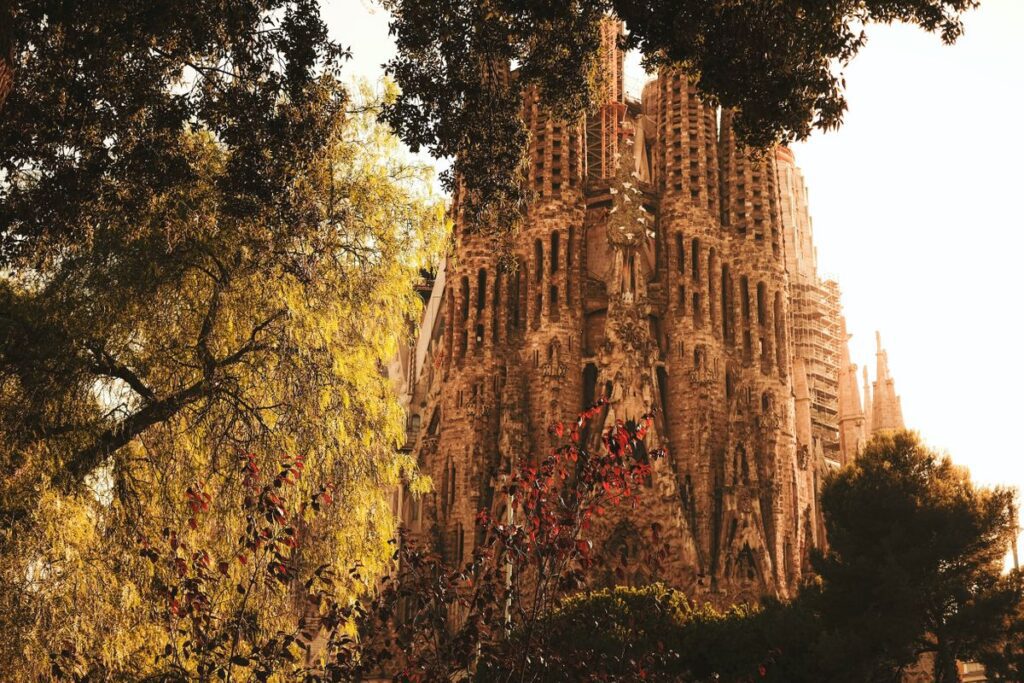

When you think of Spanish architecture, you think of the Sagrada Familia in Barcelona. Designed by Antoni Gaudí, this is the climax of the Catalan Modernism – defined by its dynamic curves, rich decoration and colourful mosaics and ceramics. But despite its grand stature, dazzling interior and intricate outer façades it actually remains an unfinished ‘work-in-progress’ (since 1883). I find this incredible because in today’s world (where time is money and most buildings are built quickly with straight lines), this wonderful church follows the original projects of Gaudí closely and his nature theme. For example: the pillars represent trees.
Today the temple has three major façades: the Nativity Façade (almost completed with Gaudí still alive), the Passion Façade (begun in 1952) and the Glory Façade (yet to be completed). It will have 18 towers when it is finished: representing 12 apostles, 4 evangelists, the Virgin Mary, and Jesus Christ (which will be 550 feet tall). And the interior will be formed by innovative sloping arborescent columns and vaults based on hyperboloids and paraboloids seeking the optimal shape of the catenary. It is estimated that it will be able to take in its choir 1,500 singers, 700 children and five organs!
RELATED CONTENT: How to spend 48 hours in Barcelona, Spain
2. The City of Arts and Sciences in Valencia
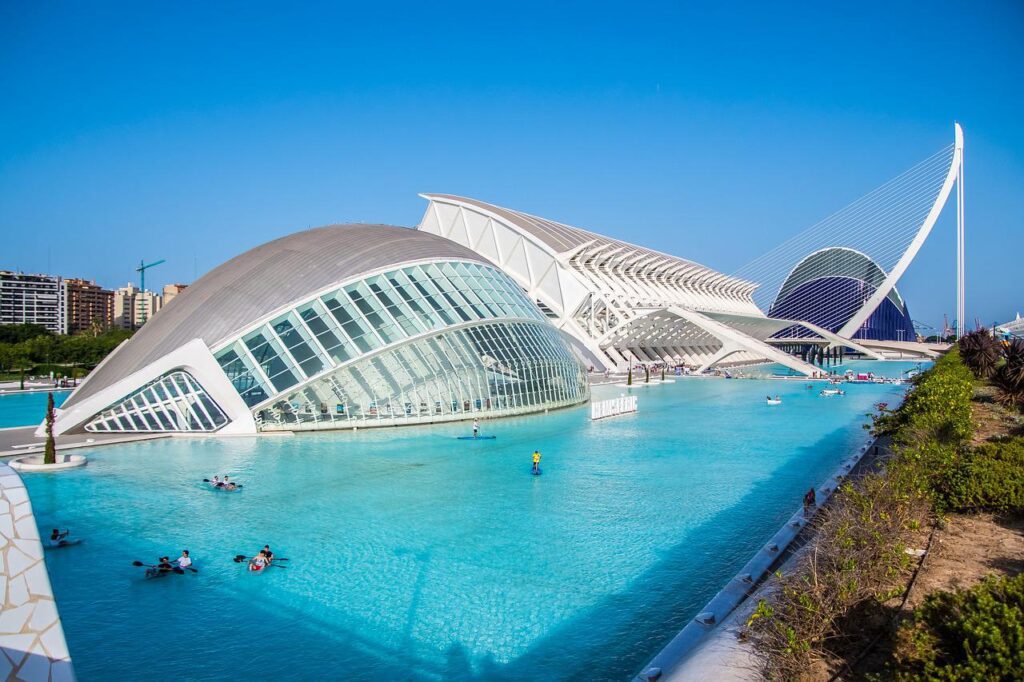

The City of Arts and Sciences is an architectural, cultural and entertainment complex located in the city of Valencia, Spain. It is a wonderful example of contemporary Spanish architecture built in the old course of the river Turia, which was diverted to the outskirts of the city. Visitors are spoiled for choice here. From kayaking and pedal boating in the surrounding water to roaming the nearby Turia gardens: a long park with sports facilities and lush gardens. Admire bronze sculptures outside. Then venture inside to explore the massive opera house, 3D concave cinema and interactive science exhibits.
But before you go… make time for the l’oceanogràfic. This is the largest aquarium in Europe, full of 45,000 living creatures and species 500 different species including dolphins, belugas and sea lions. Incredible fun for the family.
GET INSPIRED BY: Best of Spain tour
3. Alhambra in Granada
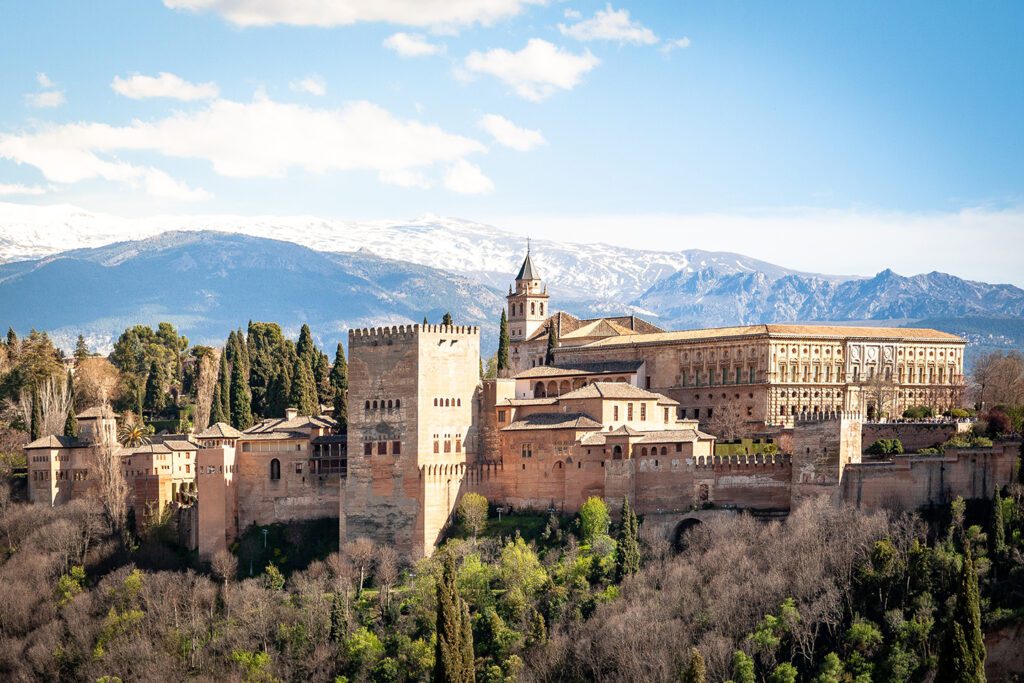

The Alhambra is a palace and fortress complex located on a rocky hill in Granada, Southern Spain. Combined with the neighbouring Generalife (a beautiful garden villa) and the Albaicín district, they constitute a UNESCO World Heritage Site. Nicknamed the ‘The Red Castle’, the Alhambra truly is a sight to behold.
Its mix of Medieval Islamic and Renaissance Christian architecture speaks to its history of Muslim and Christian occupation (at different times). It fortress of enclosed palaces and courtyards housed the monarch of the Nazaries dynasty in the 13th century and the court of the Kingdom of Granada. And like many Muslim works of the time, the interiors are its outstanding attraction. Particularly the marble floors, stucco-work, colourful azulejos (tiles) and elaborate wooden ceilings. Without a doubt, this is the number one attraction to visit in Granada if you love Spanish architecture.
RELATED CONTENT: 9 UNESCO World Heritage Sites to see in Spain
4. Guggenheim Museum in Bilbao
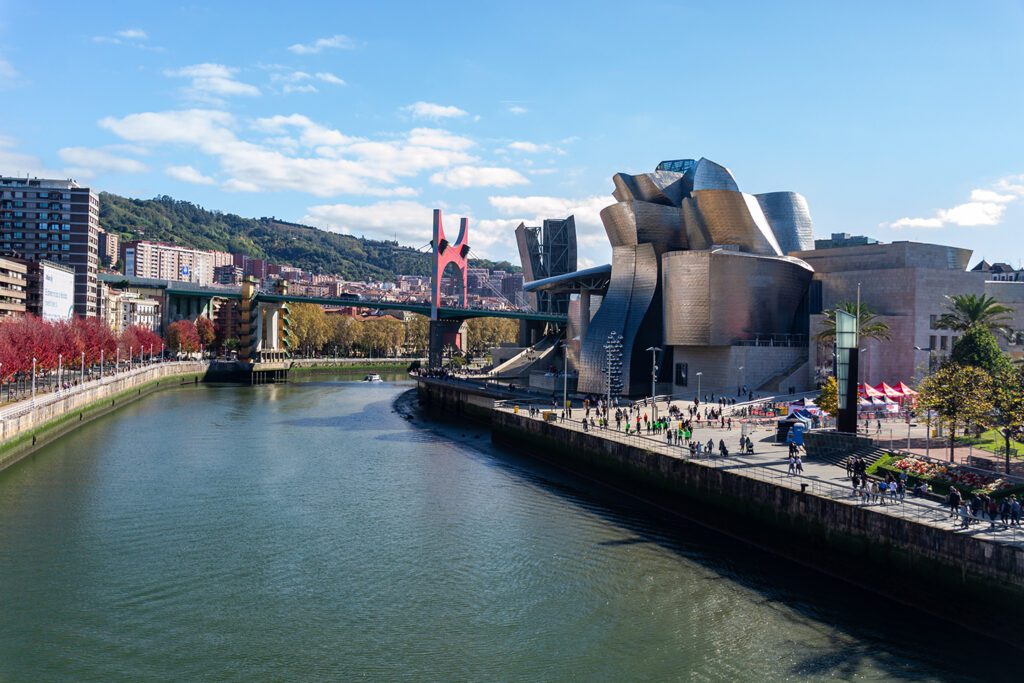

Located in the Basque city of Bilbao, a 15-minute walk from the centre, you cannot miss the Guggenheim Museum. One of the most visited sites in Spain and a unique icon of Spanish architecture.
It was born from a collaboration of the Basque Institutions and the Solomon R. Guggenheim Foundation to revitalize Bilbao’s urban art and culture scene. Despite doubts from experts during its construction (1992-1997) who questioned how it was possible to use complex shapes with twisting curves, it rose to the challenge and proved many people wrong – succeeding in its mission. I love that this piece of Spanish architecture challenges all logic of construction and gives us an unusual and impressive beauty on Bilbao’s renovated Nervión riverfront.
Visitors must take time to admire the outside (including the sculptures); before exploring the modern and contemporary art exhibitions inside. As well as the futuristic section and famous car exhibition.
RELATED CONTENT: Brilliant places in Spain for a sunny winter getaway
5. Plaza de España in Seville
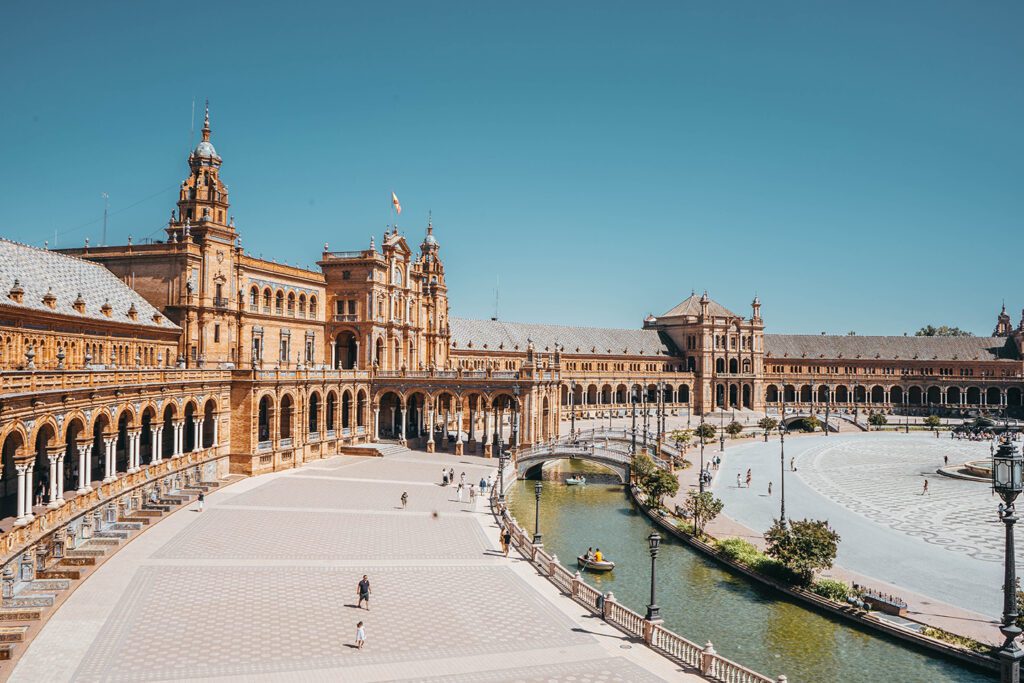

Plaza de España is a square in Parque de María Luisa, Seville. A stone’s throw from the city centre, this beautiful park was built for the Ibero-American Exposition of 1929. It is a striking example of Regionalism in Architecture, which mixes elements of Neo-Renaissance, Neo-Mudéjar and Spanish architectural styles.
When you arrive, head off on a gorgeous walk anywhere around this 494,410 square foot semi-circle to gaze at botanical gardens, elegant buildings and the grand fountain in the middle. You will spot 52 painted tile frescoes that reflect Spain’s 52 unique provinces – each full of exquisite detail. There’s also a chance you’ll stumble across a flamenco show and violinists in action!
Plaza de España is must visit in Seville (in southern Spain’s Andalusian region) especially in the morning when it is still cool.
Check out more astounding architecture on our Spanish Wonder tour.
FAQ
What are the most famous architectural landmarks in Spain?
The most famous architectural landmark in Spain is arguably the La Sagrada Familia in Barcelona, Spain. It’s regularly the most visited attraction in the country as well. Other famous and popular architectural landmarks in Spain include The Alhambra in Granada, the Guggenheim Museum in Bilbao, and the Royal Alcazar of Seville.
What are some examples of Moorish architecture in Spain?
Moorish architecture is an Islamic-style design using geometric details, horseshoe arches, and plasterwork patterns. Some examples of Moorish architecture in Spain include the Castle of Gormaz, the Torre del Oro, Calahorra Tower, Real Alcázar de Sevilla, and The Alhambra.
When will La Sagrada Familia be finished?
Barcelona’s La Sagrada Familia is no longer scheduled for completion by 2026. Due to delays caused by the pandemic, the updated completion date is 2033. If the La Sagrada Familia is finished in 2033, it will be 150 years after Gaudí took on the project.
Who designed La Sagrada Familia?
The La Sagrada Familia is an exceptional example of Spanish architecture attributed to Antoni Gaudí. The original project was designed by Francisco de Paula del Villar in 1882, but he was replaced a year later after disagreeing with Bishop Urquinaona. Domènec Sugranyes, Gaudí’s disciple, took over after Gaudí’s death in 1926. The latest architect to take over is Jordi Faulí, continuing with Gaudí’s original plans.
Who designed the Guggenheim Museum in Bilbao?
The Guggenheim Museum was designed by Frank Gehry and built between October 1993 and October 1997. It’s considered one of his most important works due to its mathematically complex design. The Guggenheim Museum in Bilbao has won over 70 awards around the world including the AIA’s Twenty-Five Year Award.
How long should I spend at the Plaza de España?
You should devote one to three hours to visiting the Plaza de España. The best time to avoid crowds is in the early morning, which could shorten your visit. Some visitors suggest visiting in the evening so you can watch the sunset. If you’re visiting other nearby attractions like Maria Luisa Park, then consider spending a half-day in the area.
See the best architecture of Northern Spain on our 11-day tour.
Attracted by Spanish architecture? Head to our Spain destination page to start your adventure now.
Alexandre Rodrigues has over 20 years of experience as a travel and tour director. Based in Porto, Portugal, he’s run Trafalgar’s Spanish tours for over a decade.